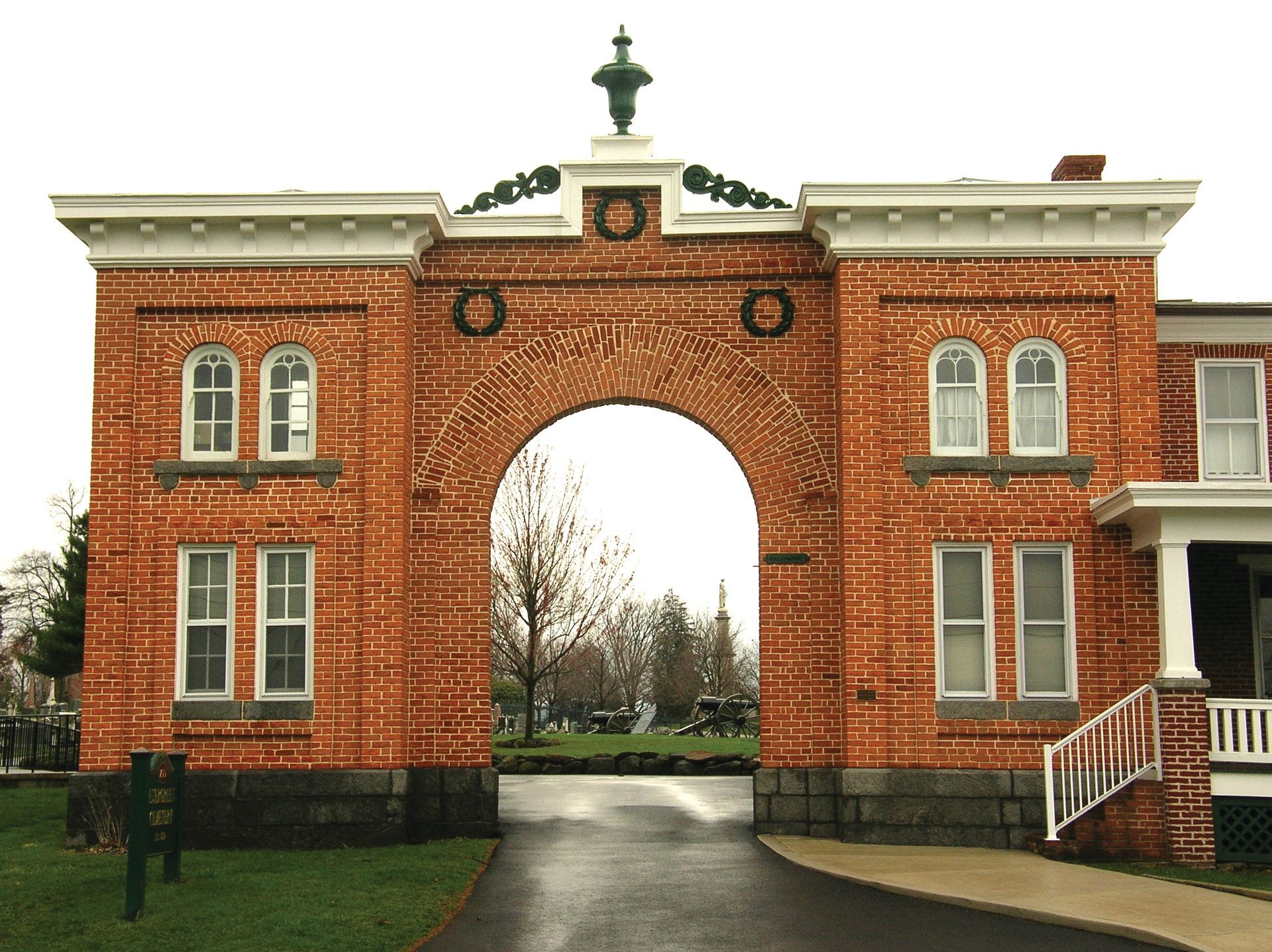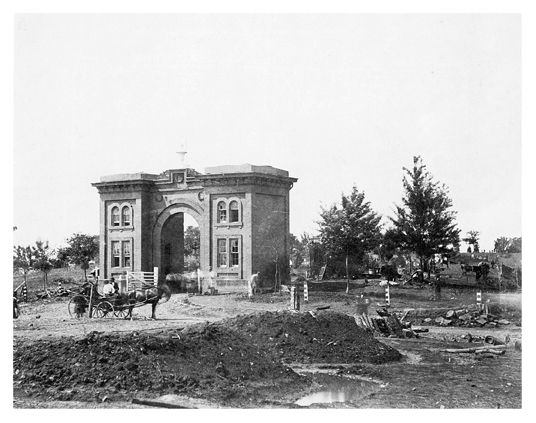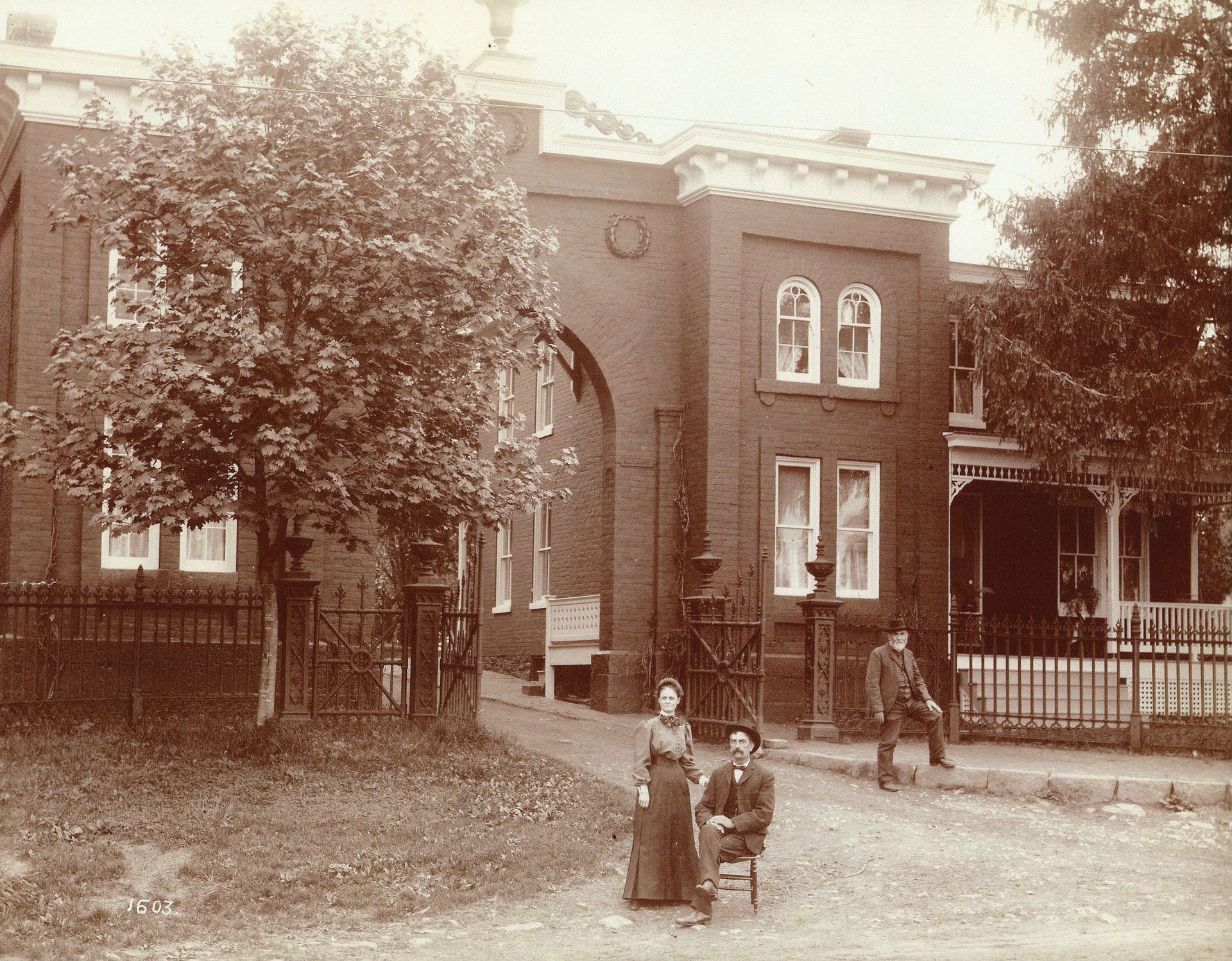Evergreen Cemetery: A Sacred History
by Diana Loski

The Evergreen Cemetery Gatehouse
(Author photo)
There is so much about Gettysburg that is historic, pivotal, and sacred.
One place that shares all three perspectives is Evergreen Cemetery, located on Cemetery Hill. The eponymous name was given because of the civilian cemetery that was created there, established in 1854.
The cemetery is iconic, largely because of its essential function during the Battle of Gettysburg; yet, Evergreen’s role transcends the time of the battle, and offers a most unique history.
Before it was Cemetery Hill, the prominent elevation just south of town was known as Raffensperger’s Hill. It was owned in the early 19th century by prosperous farmer Peter Raffensperger, who was born in 1706. He and his wife, Elizabeth, had one daughter, Anna, who married Henry Culp, the owner of the neighboring Culp’s Hill. 1
When Raffensperger wished to retire and live with his daughter and son-in-law at the Culp Farm, he sold the hill. In November 1853, the call for the creation of a new cemetery began, and by the following year, Evergreen Cemetery was organized. The original president was David McConaughy, and the first caretaker hired was Peter Thorn. Peter and his wife, Elizabeth, both German immigrants, moved into the new gatehouse in February 1856, a few months after it was completed.
The gatehouse, which is symbolic of the gates of heaven, remains one of Gettysburg’s most recognized structures. The Thorn family moved into the gatehouse with Elizabeth’s aged parents. The couple soon had children. By the time of the Civil War, three sons had arrived: Frederick, George, and John.
In August 1862, Peter Thorn enlisted to fight with the 138th Pennsylvania Regiment. He left for the war, leaving Elizabeth in charge of the cemetery.
When the war came to Gettysburg in the summer of 1863, Elizabeth Thorn, her parents, and her three sons were required to leave their home on Cemetery Hill for a safer place.
Cemetery Hill formed a portion of the Union army’s defensive battle line. The Union army rallied there after losing ground to the west of town during the battle’s first day, and part of the 2nd day’s battle was fought on the burial grounds. Cannon were placed in the cemetery, and artillery shells destroyed many of the more prominent stones. One Union soldier remembered, “ I rode through the cemetery on Cemetery Hill. How those quiet sleepers must have been astounded in their graves when the twenty-pound Parrott guns thundered above their gravestones! The flowers, roses, and creeping vines…were trampled to the ground, and black with the cannon’s soot. A dead horse lay by the marble shaft, and over it the marble finger pointed to the sky….Such are the incongruities and jumblings of battle.” 2
When the armies left the field and Mrs. Thorn returned, the gatehouse was heavily damaged, no windows were left unbroken, and most of the furniture and food were gone. Expectant with her fourth child, Elizabeth received a note from David McConaughy, requiring her to help bury the myriad dead.
While the National Cemetery was not yet planned, Elizabeth and her father buried 91 Union soldiers in Evergreen. After completing the terrible task, Elizabeth wrote that “ my health failed and for years I was a very sickly woman.” Her baby, too, was sickly, and the child, a daughter, did not live to adulthood. 3
On November 19, 1863, the National Cemetery, located on the northwestern side of Cemetery Hill, was dedicated, and President Lincoln, among other dignitaries, attended the ceremonies. Evergreen Cemetery again played an essential role in the ceremony, as the dais from which Lincoln spoke was located on the civilian side of the hill.
Nearly thirty slain Union soldiers were relocated from the cemetery once Peter Thorn returned from the war. Sixty-three graves of Union soldiers, buried by Mrs. Thorn, remain on the rocky hillside of Evergreen. Elizabeth, who died in 1907, is buried not far from where she labored during the summer of 1863. The Gettysburg Women’s Memorial, fashioned in her likeness, is found near the entrance to the cemetery.
Peter Thorn resigned as caretaker of the cemetery in 1875. He was replaced by William Pfeffer. During his tenure as caretaker, an addition was placed on the gatehouse, and a trolley line for tourists of the battlefield was added on the edge of the property.
With Mr. Pfeffer’s passing in 1895, Harry Trostle was hired as superintendent of the cemetery. During his twenty-five years at Evergreen, porches were added to the historic gatehouse and six cannon, reminiscent of the battle, were placed in the cemetery. At the turn of the century, the monument over the grave of Jennie Wade, the only civilian killed during the battle, was placed and dedicated the following year.
Although Jennie was the only civilian killed during the battle, she was not the only casualty from the fight at Gettysburg. The cemetery holds a few others within its grounds who also suffered from the historic battle. John Burns, the civilian who fought with the Union troops and was wounded but survived, is buried in the cemetery. Two youths who were killed by exploding shells a few months after the armies vacated the ground, James Culp and Allen Frazier, are also interred in Evergreen.
There are just a few places in the world where the U.S. flag flies officially 24-hours a day. Two of them are in Gettysburg’s Evergreen Cemetery, over the graves of Jennie Wade and John Burns.

The Gatehouse, 1863
(Evergreen Cemetery Assoc.)
During the tenure of Harry Trostle, the Evergreen Cemetery gatehouse was painted a dark burgundy color, with the cornices and roof ornamentation a contrasting white. Also, during this time, the trolley line was removed.
Mr. Trostle resigned in 1920, after serving for a quarter century. He was replaced by Sandoe Kitzmiller, who lived in the gatehouse for 27 years. When he resigned in 1947, his son, Howard, took over the duties of superintendent. During his tenure, the gatehouse endured some damage. Over the years, ivy grew prolifically over the front and sides of the gatehouse, even covering the windows and encroaching into the foundation of the edifice. In 1966, after the ivy was removed, the gatehouse was sandblasted, further weakening the historic brickwork.
When Mr. Kitzmiller resigned in 1974, Glenn Chronister was hired as superintendent of the cemetery. His tenure was of shortest duration, as he resigned in 1976.
Arthur Kennell became the superintendent with Mr. Chronister’s retirement, and held the position for fifteen years, retiring in 1991. A friend and caddy of President Eisenhower, Mr. Kennell worked to enhance the historic legacy of Evergreen. He oversaw the addition of a new road and entrance into the growing cemetery, adding a veterans’ section, as well as bluebird houses throughout the cemetery, increasing the number of bluebird sightings on the battlefield. When he resigned in 1991, his son, Brian, the current superintendent, was hired.
Brian Kennell, a talented musician, author and conscientious historian, is working with the Evergreen Cemetery Board of Trustees to raise funds for the restoration of the historic Gatehouse. The structure has withstood not only an epic battle, but the ravages of time and neglect.
The time-honored cemetery has many famous people of history buried on the hill, in addition to the soldiers who remain. Some of them include Gettysburg founder James Gettys, the first president David McConaughy, Peter and Elizabeth Thorn, John Burns, Mary Virginia (Jennie) Wade, baseball great Eddie Plank, Broadway actor Oscar Shaw, and celebrated poet Marianne Moore.
Also buried here are the Raffenspergers, who owned the hill when it was a farmer’s field, and their daughter’s family, the Culps.
This Gettysburg landmark played an essential role in America’s most pivotal battle, but even so, the Evergreen Cemetery’s history began before the battle, and its history has continued long after the guns were silenced in the summer of 1863, and after Lincoln ‘s immortal words reverberated across the hill a few months later.
Its legacy endures, and so must the historic gatehouse.

Gatehouse circa 1900


